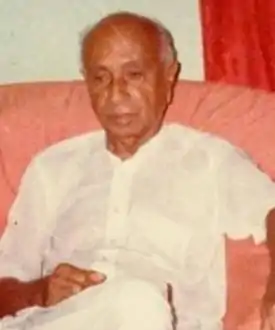غلام مرتضى سيد
غلام مرتضى سيد (17 يناير 1904 - 25 أبريل 1995)،[1] كان سياسيًا سنديًا بارزًا،[2][3] اقتراح أسس أيديولوجية للهوية السندية المنفصلة وإرساء أسس حركة «سندو ديش».[4] يعتبر أحد الآباء المؤسسين للقومية السندية الحديثة.[5]
| غلام مرتضى سيد | |
|---|---|
 | |
| معلومات شخصية | |
| الميلاد | 17 يناير 1904 |
| الوفاة | 25 أبريل 1995 (91 سنة)
كراتشي |
| مواطنة | |
| الحياة العملية | |
| المهنة | فيلسوف، وسياسي، وشاعر |
| الحزب | الرابطة الإسلامية الباكستانية |
| اللغات | السندية |
بدأ حياته السياسية في سن 16، عندما نظم مؤتمر الخلافة في مسقط رأسه في 17 مارس 1920.[6] كان أول من أصبح سجينًا سياسيًا بعد تأسيس باكستان عام 1948.[7][8][9] وأمضى قرابة ثلاثين سنة من حياته في السجن والاعتقال المنزلي لمناداته بالقومية السندية.[10] وقد وصفته منظمة العفو الدولية بأنه سجين رأي في عام 1995.[11] توفي أثناء إقامته الجبرية في كراتشي في 26 أبريل 1995.[12]
المراجع
- Zaffar, Junejo (19 Jan 2015). "G M Syed: Remembering a visionary". tribune.com.pk (بالإنجليزية). The Express Tribune. Archived from the original on 2018-08-11. Retrieved 2018-05-23.
- Google، Books. "author G.M Syed". مؤرشف من الأصل في 2020-04-28. اطلع عليه بتاريخ 2018-05-23.
{{استشهاد ويب}}:|الأخير=باسم عام (مساعدة) - Dawn, Newspaper (24 Jun 2017). "KARACHI 1943: A PROCESSION IN TRIUMPH". dawn.com (بالإنجليزية). داون (صحيفة). Archived from the original on 2018-07-07. Retrieved 2018-05-23.
- "'No China, Go China' slogans reverberate at JSMM rally in Sindh". aninews.in (بالإنجليزية). Asian News International. 19 Jan 2018. Archived from the original on 2018-07-07. Retrieved 2018-05-23.
- Farhan Hanif Siddiqi (4 مايو 2012). The Politics of Ethnicity in Pakistan: The Baloch, Sindhi and Mohajir Ethnic Movements. Routledge. ص. 76–. ISBN:978-1-136-33697-3. مؤرشف من الأصل في 2020-04-28. اطلع عليه بتاريخ 2018-05-23.
- Rita Kothari (1 Feb 2007). The burden of refuge: the Sindhi Hindus of Gujarat (بالإنجليزية). Orient Longman. p. 48. ISBN:978-81-250-3157-4. Archived from the original on 2016-12-21. Retrieved 2018-05-25.
- World Sindh، congress. "Statement by Dr. Haleem Uddin Bhatti, Information Secretary, World Sindhi Congress". worldsindhicongress.org. World Sindhi Congress. مؤرشف من الأصل في 2018-07-07. اطلع عليه بتاريخ 2018-05-23.
- KHADIM، SOOMRO (20 يناير 2009). "G.M. Syed remembered". dawn.com. داون (صحيفة). مؤرشف من الأصل في 2019-11-01. اطلع عليه بتاريخ 2018-05-22.
- Nadeem F. Paracha (10 Sep 2015). "Making of the Sindhi identity: From Shah Latif to GM Syed to Bhutto". dawn.com (بالإنجليزية). Dawn. Archived from the original on 2019-11-01. Retrieved 2018-05-23.
- Naseer, Memon (17 Jan 2013). "Relevance of GM Syed today". tribune.com.pk (بالإنجليزية). The Express Tribune. Archived from the original on 2018-08-07. Retrieved 2018-05-23.
he remained interned for over 30 years
- Amnesty International (1995). Amnesty International: The 1995 Report on Human Rights Around the World. Hunter House. ISBN:978-0-89793-183-0. مؤرشف من الأصل في 2020-04-28.
- Suranjan Das (2001). Kashmir and Sindh: Nation-building, Ethnicity and Regional Politics in South Asia. Anthem Press. ص. 140–. ISBN:978-1-898855-69-9. مؤرشف من الأصل في 2020-04-28. اطلع عليه بتاريخ 2018-05-23.
- بوابة أدب
- بوابة أعلام
- بوابة السياسة
- بوابة القرن 20
- بوابة باكستان
- بوابة فلسفة
This article is issued from Wikipedia. The text is licensed under Creative Commons - Attribution - Sharealike. Additional terms may apply for the media files.
